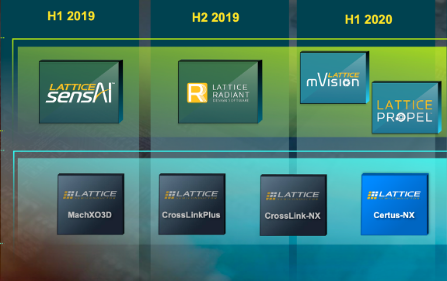What breakthroughs do low-power general-purpose FPGAs need for edge devices?
Lattice (Lattice) has announced the launch of the new Lattice Certus-NX series of FPGAs for a range of applications ranging from data processing in automated industrial equipment to system management in communications infrastructure. It is said that the I/O density per square millimeter of this product can be up to twice that of similar FPGA competitors. It has the characteristics of low power consumption, small size, high reliability and instant start, and supports high-speed PCI Express (PCIe) and Gigabit. The Ethernet interface can realize data collaborative processing, signal bridging and system control.
This is within half a year. LatTIce is the second FPGA product based on the LatTIce Nexus platform. The first product is for embedded vision, and the new products released this time are mainly for industrial, communications and other application fields.

Redefining a general-purpose FPGA around seven features
With the development of technologies such as industrial automation and 5G, developers began to seek to add processing and interconnection functions to network edge applications. To comply with this trend, these devices require low-power processing hardware that supports common interfaces such as PCIe and Gigabit Ethernet. Device developers also need easy-to-use, unified development platforms that provide the hardware, software, and IP needed to quickly bring products to market.
Based on the latest trends in data processing, serial protocols such as PCIe and Ethernet are being widely used in chip connections for systems such as 5G and IoT. According to Jeffery Pu, Field Technical Support Director of LatTIce, the latest generation of Certus-NX FPGA not only supports these standards, but also provides high-density I/O while reducing power consumption and the design size of the entire device, parallel processing capabilities and Flexible I/O support can redefine what developers expect from a general-purpose FPGA.
Lattice Field Technical Support Director Jeffery Pu
The main features of Certus-NX FPGA include:
The size is reduced by up to 3 times-Certus-NX FPGA can realize a complete PCIe solution within 36 mm2. Even with the smallest package in the Certus-NX FPGA family, its I/O density per square millimeter is still twice that of competing FPGA products, providing greater design flexibility and powerful support for bridge applications.
High reliability-For industrial and automotive applications where safety is extremely demanding, reliable performance is critical. The devices in these applications must achieve the expected performance to avoid damage to people and property. Certus-NX FPGA's soft error rate (SER) performance is up to 100 times that of similar FPGAs. Certus-NX FPGA is an industrial temperature grade device. It also supports on-chip ECC and SEC.
Strong authentication and encryption-To protect the device's bit stream from unauthorized access/change/copy, Certus-NX FPGA supports AES-256 encryption and leading ECDSA authentication, providing protection throughout the entire life cycle of the device .
Reliable I/O connection performance-Certus-NX developers can use LatTIce's complete IP library. The main IPs that can be used on Certus-NX include: 1.5Gbps differential I/O, which exceeds the highest performance of competing FPGAs 70%; 5Gbps PCIe, 1.5 Gbps SGMII and 1066 Mbps DDR3. Developers can test these IP modules on the Certus-NX development board to quickly implement commonly used interfaces in Certus-NX FPGA target applications.
Power consumption is reduced by up to 4 times-the programmable substrate bias function of Certus-NX FPGA can choose high-performance or low-power operating mode according to user application requirements. Compared with similar FPGAs, the power consumption of this series of devices can be reduced by up to 4 times.
Instant start-up-the new device also implements fast device configuration through SPI memory, which can be up to 12 times faster than similar FPGAs. A single I/O configuration takes only 3ms, and the entire device startup time is 8-14ms (depending on device size).
Easy to use/design-Certus-NX FPGA supports easy-to-use LatticeRadiant software, which provides a unified FPGA design environment that helps users develop applications quickly and efficiently.
Differential design to meet the needs of different vertical segments
Also based on the Lattice Nexus platform, what is the biggest difference between the Certus-NX FPGA and the previous CrossLink-NX? According to Jeffery, the biggest difference is that Certus-NX removes the MIPI hard core in order to increase the number of I/O. This is the I/O improvement space found when promoting the
previous generation of products. PCIe is used for market segments. Some customers with ordinary controls are very helpful; the second difference is that in terms of safety certification, the new product adds ECDSA certification, which is also inspired by previous generations of products and can provide protection during the entire life cycle of the device.
Talking about the advantages of the new FPGA, Jeffery said that the FD-SOI process has brought power consumption reduction and soft error rate reduction to the Nexus platform itself. In addition, innovative design at the chip level will contribute to the further breakthrough of this general-purpose FPGA For example, for traditional FPGA, SPI Flash is usually added, the speed of FPGA often depends on how fast SPI can run, and the new SPI Flash is specially configured inside the chip, and four channels can be used to write data. Helps greatly reduce the configuration time.
It is understood that the Lattice Nexus platform is based on the 28nm FD-SOI process. Due to its innovations at the system, architecture, and circuit levels, Lattice can accelerate the introduction of new products. This also means that under the guidance of new product development strategies, Lattice's general purpose FPGA camp for the vertical field is growing.
If you want to know more, our website has product specifications for low-power general-purpose FPGAs, you can go to ALLICDATA ELECTRONICS LIMITED to get more information

